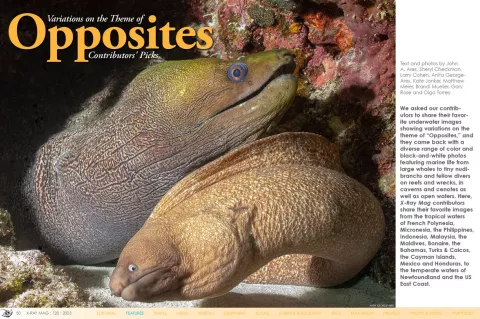We asked our contributors to share their favorite underwater images showing variations on the theme of “Opposites,” and they came back with a diverse range of color and black-and-white photos featuring marine life from large whales to tiny nudibranchs and fellow divers on reefs and wrecks, in caverns and cenotes as well as open waters.
Contributed by
(To see all the images in the article, please scroll down to the end and download the article PDF.)
Here, X-Ray Mag contributors share their favorite images from the tropical waters of French Polynesia, Micronesia, the Philippines, Indonesia, Malaysia, the Maldives, Bonaire, the Bahamas, Turks & Caicos, the Cayman Islands, Mexico and Honduras, to the temperate waters of Newfoundland and the US East Coast.
Facings, Phases, Color and Camouflage
Text and photos by Anita George-Ares, PhD
A large, undulated moray faces the opposite direction of the smaller, white-eye moray (in the photo above). Moray eels are abundant at the Fish Factory dive site in the Maldives. The daily dumping of processed fish waste ensures an abundance of marine life.
A school of crescent-tail bigeyes (Photo 2) also inhabits the Fish Factory site. The bright red phase of some fish is the opposite of the pale, silvery phase displayed by the other fish in the school.
Photo 3 shows two sleek unicornfish. This species exhibits a variety of color patterns that can quickly change. The colors are not gender-specific. The bottom fish displays opposing light and dark colors.
Male flamboyant cuttlefish are typically smaller than the females. The cuttlefish depicted in Photo 4 are of similar size, but the female on the right differs by being camouflaged and flattened (Hanlon and McManus, 2020). The bold-colored males (left and center) display three pairs of arms whereas the female does not. Visit: facebook.com/profile.php?id=100016947967639
REFERENCE:
Hanlon, R.T., and G. McManus. (2020). Flamboyant cuttlefish behaviour: Camouflage tactics and complex colourful reproductive behaviour assessed during field studies at Lembeh Strait, Indonesia. Journal of Experimental Marine Biology and Ecology 529. Https://doi.org/10.1016/j.jembe.2020.151397
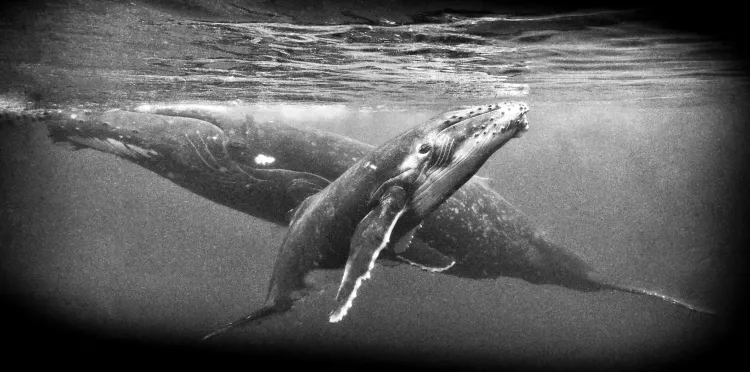
Size, Facing and Direction
Text and photos by John A. Ares
First up, for the theme of “opposites,” is size (big vs. small). The mother humpback is around 45 to 50ft long, while the calf is about 15ft (Photo 1). The calf is about three months old and needs to surface every five minutes to breathe. The mother can stay down typically for 20 minutes on a breath.
In Photo 2, the spadefish and cleaner wrasse were different sizes and facing different directions. Their eye contact was riveting as the wrasse was trying to sell its cleaning services. The intensity of the eye-to-eye exchange was palpable.
In Photo 3, the three squid were pulling in opposite directions. Most likely, it was two males “negotiating” to win a female. This image was taken on a night dive. In Rhode Island, shore dives in late May reliably produce squid that are “in the mood.” Bright, moon-lit nights were productive. They were pairing up in the day also.
Photos 4 and 5 shows a side-by-side comparison of two Rhinopias scorpionfish (facing opposite directions, contrasting in color, with light vs. dark backgrounds) in the Indo-Pacific Coral Triangle. The purple one was in North Sulawesi, Indonesia. The orange Rhinopiasscorpionfish was in Puerto Galera, Philippines. Rhinopias scorpionfishes are not common. Due to rarity, both photos were produced with competition from other photographers. If you see a Rhinopias scorpionfish, do not waste time making 30 well-composed images. Get your three or four quick safety shots, and then negotiate the opportunity to “circle back.” Rhinopias scorpionfishes do not spook easily with careful photographers. Visit: JohnAres.com
Numbers, Textures and Conditions
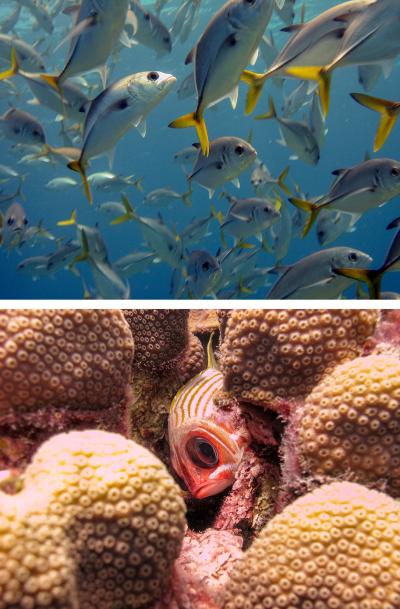
Text and photos by Sheryl Checkman
Whenever I see a school of fish swim by, the first thing I notice is how they swim as a unit, in the same direction—each individual fish just a part of the crowd—as the snappers in Photo 1, which was taken at Orange Wall in West Caicos. In contrast, the little lone squirrelfish in Photo 2 is peering out from its solitary hiding spot within the coral at the Catacombs dive site in Turks and Caicos.
The smooth and shape-altering body of the octopus, as seen at Piranha Cove in Turks and Caicos in Photo 3, has turned itself white to blend in with its surroundings, by mimicking the coloration of the sandy sea floor. In contrast, the scorpionfish in Photo 4 is using its bright color and leafy appearance to hide in plain sight, in the reef at Labyrinth Wall in Roatan, Honduras.
After spending up to an hour beneath the ocean, you never know what conditions await you on the surface. At Roatan in Honduras after diving on Nabs Dive Wall, I surfaced to find a stormy sky, choppy seas and rain pelting down upon me as I awaited my turn to climb aboard our dive boat (Photo 5). After a dive at Cumber Caves, in Little Cayman of the Cayman Islands, however, quite the opposite conditions greeted me—the sea was calm, and the skies were blue (Photo 6). Visit: Instagram.com/sherylcheckman
Warm and Cold Wrecks
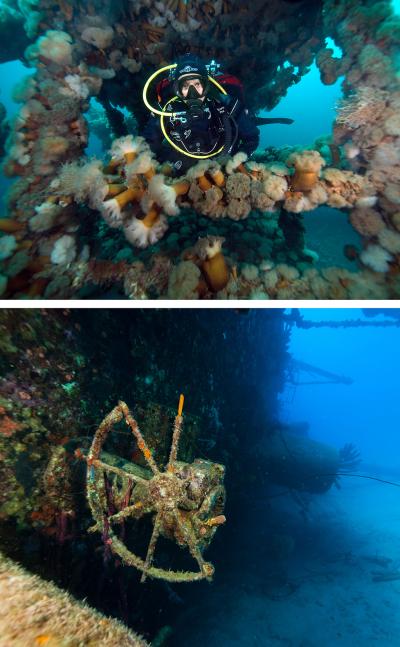
Text and photos by Larry Cohen
Shipwrecks have always been my passion. Whether I need a drysuit or a wetsuit, I enjoy diving and documenting the underwater history found on wrecks. Newfoundland is an island northeast of Nova Scotia. Ocean Quest Adventure, owned by Rick and Debbie Stanley, is a great dive operation for exploring the Bell Island wrecks. To do these dives, you need a drysuit, and a heated vest will help you be more comfortable.
The story of the Bell Island wrecks is one of the most fascinating stories of World War II. Bell Island is located near St John’s in Conception Bay. In the 1890s, high-grade iron ore was discovered and mined here. In the 1930s, a large percentage of this iron ore went to Germany for rearmament. Once World War II broke out, shipments to Germany ceased, and the iron ore was redirected to support armaments for the Allied Forces. Germany knew how vital the iron ore was to the Allied war effort, so they attempted to disrupt its flow to Europe. Doing so posed little challenge to German U-boats since Germany already knew the harbor. On September 4th and November 4th, 1942, the German U-boat U-518entered Wabana Harbor and sunk the Rose Castle, SS Saganaga, Lord Strathcona and PLM 27. Diving these wrecks in icy waters is worth the effort.
The Hilma Hooker is a shipwreck in the bathtub-warm waters of Bonaire. In 1984, the Hilma Hooker had engine problems and was towed to Kralendijk, Bonaire. When docked at the town pier, the ship was inspected, and authorities found 25,000 lb (11,340kg) of marijuana behind a fake bulkhead. The vessel was held as evidence for months and started to take in water. It was towed to an anchorage and, on 12 September 1984, took in water, rolled over on its starboard side, and sank in 100ft (30m) of water. My dive buddy, Olga Torrey, and I did the wreck as a shore dive and had to swim for about 15 minutes to get to the buoy that marks the wreck’s location. Exploring the ship’s exterior and interior in the comfortable water temperatures there was a pleasure. Visit: liquidimagesuw.com
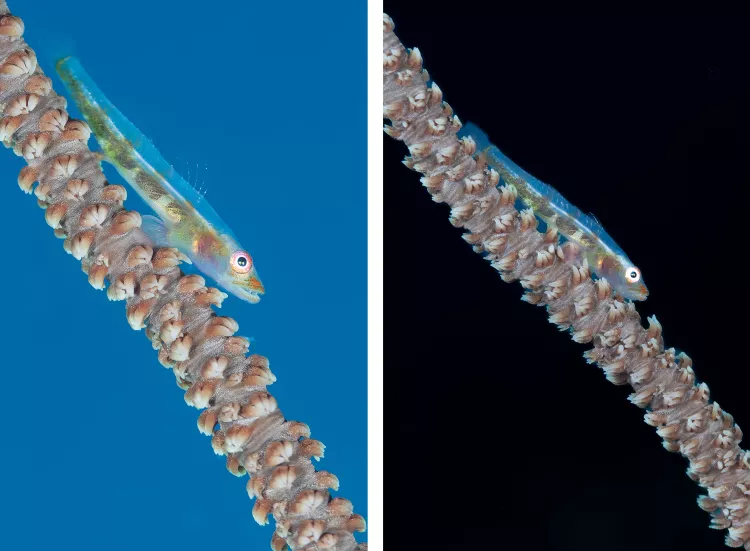
Same Subject, Opposite Effects
Text and photos by Kate Jonker
Using your camera settings and lighting are a wonderful way to create different results when photographing the same (or similar) subject. It helps add interest to your portfolio, continues to challenge your photography skills and keeps you thinking “outside of the box.”
Dark vs light backgrounds. To achieve a light background, use a slower shutter speed, wider aperture, and higher ISO. In contrast, for a dark background, opt for a fast shutter speed, small aperture, and lowest ISO. Use your strobes to light your subject. When using this technique, look for a subject that only has the water column behind it.
All in focus vs little in focus. A wide-open aperture creates a shallow depth of field, separating your subject from the background and foreground, producing a pleasing blurry bokeh effect. On the other hand, a completely different image can be created using a smaller aperture to ensure the subject and surrounds are more in focus.
Next time you embark on a macro dive, try employing these techniques to capture the completely opposite images of the same subjects. It promises an enjoyable experience, yielding remarkably diverse photos from just a few dives. (For more images from the Philippines, see my article on Romblon in this issue.) Visit: katejonker.com

Color vs Monochrome
Text and photos by Matthew Meier
For my take on the theme of “opposites,” I thought I would give readers a sneak peek at a few images from my recent travels to Truk (Chuuk) Lagoon in Micronesia (see the full article in issue #121). Back in March, I had the pleasure of diving, with Master Liveaboards,at what is often referred to as the wreck-diving capital of the world and thoroughly loved the experience!
I was immediately struck by the amount of life—both coral, and invertebrate and fish species—that were growing on and swimming around these decaying man-made structures, which have been underwater for nearly 80 years. It is sobering to consider the immense loss of human life, resources, materials and ingenuity embodied by these wrecks, which have now provided artificial homes for so many other creatures.
These images also illustrate the theme of “opposites” by comparing color and monochrome images, either as a different view of the same scene or as dissimilar ways to photograph a kindred subject. The engine room on the Kensho Maru, I believe, has more contrast, depth and clarity in black and white than when viewed in color. The soft corals and fish life on the king posts of several wrecks were spectacular, and here, they are captured up-close with strobes to highlight that kaleidoscope of color, and far away with available light to showcase the structure itself. Visit: MatthewMeierphoto.com
Juvenile vs Adult

Text and photos by Brandi Mueller
When I think of “opposites” in the ocean, one of the first things that come to mind is how some fish change entirely from their juvenile to adult stage. For example, the harlequin sweetlips starts out light brown with big white spots and fin tips (and they are known to dance or undulate to prevent predation by mimicking toxic flatworms or nudibranchs). Once they become adults, they are elongated and darker overall, with many dark spots, and they stop dancing.
The emperor angelfish begins a beautiful blue, with white circles, and grows up to have blue stripes with a mostly yellow body, white face, and black eyes and fins. Other species of angelfish also have very contrary juvenile and adult stages. The French angelfish starts out black, with yellow stripes, and becomes grayer, with yellow scales, as an adult. The queen angelfish has orange on its lower body, as well as blue and dark stripes. As an adult, it becomes greener and bluer throughout, with yellow accents and a crown of blue on its head. Visit: brandiunderwater.com
Opposites do Attract!
Text and photos by Gary Rose, MD

I am not one who likes to quote clichés. But in this case, for this article, there could not be a better title than “Opposites do Attract!” As soon as I thought about which photos to use to illustrate this story, my thoughts immediately brought me to these four photos, which are two pairs of night and day captures. They absolutely draw me in and attract me every time I view them.
There is a definite contrast between the mystery and primeval fear engendered in seeing sharks at night, when compared to viewing them during the day, as they glide through the sea. We can all thank the movie Jaws for that. The same beautiful sharks, when seen in daylight, evoke a feeling of warmth and curiosity. Sharks, by nature, are very inquisitive and cannot help but provoke wonderment and curiosity when we see them in the water or view them in photographs.
In Photo 1, we can immediately feel the mystery of this beautiful, metallic-appearing tiger shark, emerging from the blackness behind her. The subtle pink of her mouth draws attention to her razor-sharp, serrated teeth. Also, the power of her body is clearly seen, as it fades into the dark behind her. In Photo 2, the crystal-clear and warm tropical water, at the transition between sand and healthy seagrass, creates a sense of comfort and ease. Yes, this is a tiger shark—so NEVER LOSE EYE-TO-EYE contact. Whenever I shoot shark photos, particularly of ambush hunters such as tiger sharks and great white sharks, I always use a very wide-angle lens and shoot from the hip.
Photo 3 is very similar to Photo 1, at first glance—a shark emerging from a black void. But, in this photo, this lemon shark does not portray anything near the menace of the tiger shark. Notice that in this photo, the subtle pink of the mouth also draws your immediate attention to her needle-like teeth. In fact, she appears to be smiling, which is something lemon sharks regularly appear to do. These are helpful shark-identifying features, which help make a dive more interesting and safer for a diver who understands and recalls the differences in shark behavior between these two species.
Photo 4 was taken on a daylight dive, and therefore automatically not as threatening to divers and photographers. The beautiful and curious lemon shark in the photo has come over to visit and investigate the diver, and me, the photographer. Have you noticed the big smile on the diver’s face? Lemon sharks are among the friendliest and most fun to have around during a dive. They are exceptionally social and love to play like puppy dogs!
Night and day, each create a totally different atmosphere. Dark—foreboding and mysterious. Day—warm, inviting and friendly. They are Yin and Yang—opposite, but interconnected, attracting forces. Visit: garyrosephotos.com
Wavelengths and Seasons

Text and photos by Olga Torrey
Cenote Garden of Eden has crystal-clear waters, which are excellent for scuba diving and photography. It is a cavern with large rooms, huge chambers, vaults and gigantic galleries. The cenote has plenty of natural sunlight, making the diving experience on a sunny day more enjoyable. Diving with the bright blue rays shooting down from the surface in the Cenote Garden of Eden provides a mesmerizing experience and shows off the cenote at its best!
Blue light has short wavelengths and has higher energy to penetrate deeper than other colors, as seen in the Cenote Garden of Eden. Divers will find all underwater features only in blue, once they reach a certain depth. So, underwater photographers flash white light on an object underwater to capture the full spectrum of colors.
Cenote Casa is close to the ocean and is home to a mix of freshwater and saltwater fish. We can see in this cenote the diversity of flora and fauna found on the Caribbean coastline of Mexico. The cenote is separated from the sea by the beach and a tunnel of about 50 meters. The dive starts in an open water area between the mangroves.
Transparent water with a low accumulation of dissolved materials appears blue, but during the rainy season, the cenote water changes colors, because it becomes rich in phytoplankton and other algae, and usually appears green. Cenote Casa did not disappoint and gave me many opportunities for photography. Visit: fitimage.nyc
SOURCES: manoa.hawaii.edu, waterboards.ca.gov


